|
|
 |
|
Cyclopoida ( Order ) |
|
|
|
Oncaeidae ( Family ) |
|
|
|
Triconia ( Genus ) |
|
|
| |
Triconia borealis (Sars, 1918) (F,M) | |
| | | | | | | Syn.: | Oncaea conifera : Sars, 1900 (p.113, figs.F);
Oncaea borealis Sars, 1918 (p.191, figs.F,M); Früchtl, 1924 b (p.90, Rem.); Campbell, 1929 (p.329, Rem.F,M); Wilson, 1932 a (p.351, figs.F,M); Rose, 1933 a (p.303, figs.F,M); Jespersen, 1934 (p.127); 1940 (p.92); Sewell, 1948 (p.392, 496); Hansen K.V., 1951 (p.231, migration v.s. discontinuity layer); Østvedt, 1955 (p.15: Table 3, p.17, p.79); Wiborg, 1955 (p.47); Gardner & Szabo, 1982 (p.114, figs.F,M); Gagnon & Lacroix, 1982 (p.9, 12); Malt, 1983 b (p.458); 1983 a (p.6, figs.F,M, Rem.); Heron & al., 1984 (p.461, 466, figs.F,M, Rem.); Van Hove & al., 2001 (p.303); Heron & Frost, 2000 (p.1034, figs.F, tab.2, 3);
Ref. compl. : Jespersen, 1939 (p.81, Rem., Table 25); Gundersen, 1953 (p.1, 27, seasonal abundance); Grice, 1962 a (p.101); Mazza, 1966 (p.73); Maclellan D.C., 1967 (p.101, 102: occurrence); Pertsova, 1967 (p.240); Vinogradov, 1968 (1970) (p.256); Strömgren, 1969 (p.5); Shih & al., 1971 (p.56, 156, 215); Kolosova, 1975 (p.92, fig.3, Table 1); Peterson & Miller, 1975 (p.650); 1976 (p.14, Table 1, 2, 3, abundance vs. interannual variations); Shuvalov, 1976 (in Kos, 1976 (Vol. II, figs.F,M, Rem.); Gibson & Grice, 1977 (p.85, Table 1, copper pollution); Peterson & Miller, 1977 (p.717, Table 1, seasonal occurrence); Shih & Laubitz, 1978 (p.50); Kosobokova, 1980 (p.167, seasonal changes, vertical distribution, age composition); Buchanan & Sekerak, 1982 (p.41, Table 3: vertical distribution); Kovalev & Shmeleva, 1982 (p.86); Huntley & al., 1983 (p.143, Table 2); Tremblay & Anderson, 1984 (p.7); De Ladurantaye & al., 1984 (p.21, fig.5, advective processes in fjord); Groendahl & Hernroth, 1986 (tab.1); Sameoto & al., 1986 (p.53); Mikhailovsky, 1986 (p.83, Table 1, ecological modelling); Kosobokova, 1989 (p.27); Anderson J.T., 1990 (p.127, Rem.: p.131); Vinogradov & al., 1994 (tab.1); Richter, 1994 (tab.4.1a); Abramova, 1996 (tab.1); Kosobokova & al., 1998 (tab.2); Dolganova & al., 1999 (p.13, tab.1); Bragina, 1999 (p.196); Abramova, 1999 (p.161, Table 2); Halvorsen & Tande, 1999 (p.279, figs.3); El-Sherif & Aboul Ezz, 2000 (p.61, Table 3: occurrence); Kosobokova & Hirche, 2000 (p.2029, tab.2); Lischka & al., 2001 (tab.3, 6); Musaeva & Suntsov, 2001 (p.511); Lischka & al., 2001 (p.186); Fortier M. & al., 2001 (p.1263, fig.6, 7, diel vertical migration); Auel & Hagen, 2002 (p.1013, tab.2); Ringuette & al., 2002 (p.5081, Table 1, Fig.7, population dynamic); Sameoto & al., 2002 (p.13); Kosobokova & al., 2003 (p.697, tab.2); Gislason & Astthorsson, 2004 (p.472, tab.1); Dmoch & Walczowski, 2005 (p.102); Hopcroft & al., 2005 (p.198, table 2); Deibel & Daly; 2007 (p.271, Table 1, 2, Rem.: Arctic polynyas); Khelifi-Touhami & al., 2007 (p.327, Table 1); Kattner & al., 2007 (p.1628, Table 1); Humphrey, 2008 (p.84: Appendix A); Darnis & al., 2008 (p.994, Table 1, figs.8, 9); Galbraith, 2009 (pers. comm.); Dvoretsky & Dvoretsky, 2009 a (p.11, Table 2, abundance); Pomerleau & al., 2011 (p.1779, Table III); Gusmao & al., 2013 a (p.300, Rem., sex ratio); Gusmao & al., 2013 (p.279, fig.1, sex ratio vs predators, fig.4: seasonal variation of sex ratio); Eisner & al., 2013 (p.87, Table 3: abundance vs water structure);
Triconia (Oncaea) borelais : Questel & al., 2013 (p.23, Table 3, interannual abundance & biomass, 2008-2010) | | | | Ref.: | | | Böttger-Schnack, 1999 (p.43, Rem.); Nishibe & Ikeda, 2004 (p.931, Tab. 2, 4, 5); Boxshall & Halsey, 2004 (p.614: fig.F); Böttger-Schnack & Schnack, 2009 (p.131, Table 5: Rem.); Wi & al., 2010 (p.684, Re-descr.F,M, figs.F,M, Rem.); Vives & Shmeleva, 2010 (p.339, figs.F,M, Rem.); Wi & al., 2011 (p.601: Rem.: variations); Soh & al., 2013 (p.115, figs.F) | 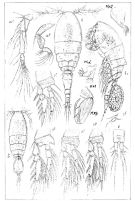 issued from : Sars G.O. in An Account of the Crustacea of Norway. Vol. VI. Copepoda Cyclopoida. Published by the Bergen Museum, 1918. [Pl. CVIII]. As Oncaea borealis. Female & Male (from Oster Fjord, near Bergen). m = Md + Mx1; mp1 = Mx2; mp2 = Mxp.
|
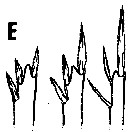 issued from : G.A. Heron & B.W. Frost in Proc. Biol. Soc. Washington, 2000, 113 (4). [p.1021, Fig.1, E]. As Oncaea borealis. Female: P2-P4 endopod terminal ''spine set'' (combination of the lengths, shapes, and position of the three or two terminal spines on the endopods of swimming legs 2-4 , from left to right in figure, for different Oncaea' species). Nota: endopod of P4 with subterminal and lateral spine lengths both about half that of terminal spine.
|
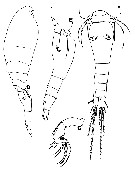 issued from : G.A. Heron, T.S. English & D.M. Damkaer in J. Crustacean Biol., 1984, 4 (3). [p.464, Fig.9, D-G]. As Oncaea borealis. Female (from Arctic): D, habitus (lateral; scale bar: y); E-F, posterior of last prosomal segment and urosome (lateral and dorsal, respectively; scale bar: w); G, right A2 (scale bar: w).
|
 issued from : G.A. Heron, T.S. English & D.M. Damkaer in J. Crustacean Biol., 1984, 4 (3). [p.467]. As Oncaea borealis. Female & Male: Armature of swimming legs P1-P4. Roman numerals: spines; arabic numerals: setae. Si = ineer setae; st = terminal setae; se = outer setae.
|
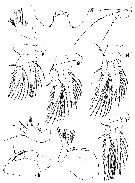 issued from : G.A. Heron, T.S. English & D.M. Damkaer in J. Crustacean Biol., 1984, 4 (3). [p.468, Fig.10]. As Oncaea borealis. Female: A, labrum (ventral; scale bar: x); B, right Md (scale bar: x); C, left Mx1 (scale bar: x); D, right Mx2 (scale bar: x); E, right Mxp (scale bar: z); F-I, P1 to P4 (scale bar: w); J, P5 (scale bar: x).
|
 issued from : G.A. Heron, T.S. English & D.M. Damkaer in J. Crustacean Biol., 1984, 4 (3). [p.469, Fig.11, A-D]. as Oncaea borealis. Male: A, habitus (lateral; scale bar: w); B, posterior of last peosomal segment and urosome ( dorsal; scale bar: w); C, right Mxp (scale bar: x); D, P5 (scale bar: x).
|
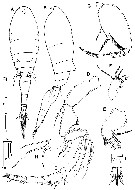 issued from : J.H. Wi, R. Böttger-Schnack & H.Y. Soh in J. Crustacean Biol., 2010, 30 (4). [p.685, Fig.8]. Female (from 36°68.33'N, 129°52.42'E): A-B, habitus (dorsal and lateral, respectively); C, A1; D, A2 (ornamentation on coxobasis obscured, not discerned); E, Md; F, Mx1; G, Mxp; H, P5; I, anal somite and caudal ramus (dorsal view), setae IV and V. Scale bars in micrometers.
|
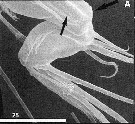 issued from : J.H. Wi, R. Böttger-Schnack & H.Y. Soh in J. Crustacean Biol., 2010, 30 (4). [p.687, Fig.10 A]. Female (SEM photograph): A, A2, distal endopodal segment (arrow indicatig ornamentation). Scale bar in micrometers.
|
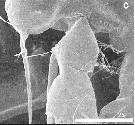 issued from : J.H. Wi, R. Böttger-Schnack & H.Y. Soh in J. Crustacean Biol., 2010, 30 (4). [p.687, Fig.10 C]. Female (SEM photograph): C, P1 (part of basis and proximal segments of endopod (anterior view), showing inner basal seta. Scale bar in micrometers.
|
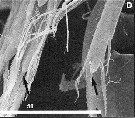 issued from : J.H. Wi, R. Böttger-Schnack & H.Y. Soh in J. Crustacean Biol., 2010, 30 (4). [p.687, Fig.10 D]. Female: D, endopodal segments 3 of P3 and P4 (arrows indicating apical pores on conical processes) Scale bar in micrometres.
|
 issued from : J.H. Wi, R. Böttger-Schnack & H.Y. Soh in J. Crustacean Biol., 2010, 30 (4). [p.687, Fig.10 B]. Female (SEM photograph): B, genital apertures (arrows indicating spinous processes close to seta of P6). Scale bar in micrometers.
|
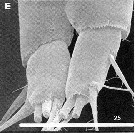 issued from : J.H. Wi, R. Böttger-Schnack & H.Y. Soh in J. Crustacean Biol., 2010, 30 (4). [p.687, Fig.10 E]. Female (SEM photograph): E, caudal rami (ventral view). Scale bar in micrometers.
|
 Issued from : H.Y. Soh, S.Y. Moon & J.H. Wi in Invertebrate Fauna of Korea (eds) Incheon: NIBR, 2013, 21 (28). [p.116, Fig.66]. Female (from Korean waters): A-B, habitus (dorsal and lateral, respectively); C, A1; D, A2; E, Md; F, Mx1; G, Mxp; H, P5; I, anal segment and caudal rami. Scale bars: A, B = 100 µm; C, I = 50 µm; D-H = 20 µm.
|
 Issued from : H.Y. Soh, S.Y. Moon & J.H. Wi in Invertebrate Fauna of Korea (eds) Incheon: NIBR, 2013, 21 (28). [p.117, Fig.67]. Female: A, P1; B, P2; C, P3; D, P4. Male: E-F, habitus (dorsal and lateral, respectively); G, P1; H, P2; I, P3; J, P4; K, abdomen (dorsal). Scale bars: A-F = 100 µm; G-K = 50 µm.
|
 Issued from : M.S. Kos in Field guide for plankton. Zool Institute USSR Acad., Vol. II, 1976. After Sars, 1918, compiled by B.S. Schuvalov, 1976, As Oncaea borealis. Female and male.
| | | | | Compl. Ref.: | | | Blachowiak-Samolyk & al., 2006 (p.101, tab.1); Willis & al., 2006 (p.39, Table 2, advection vs changes in community structure); Hop & al., 2006 (p.182, Table 4, 5: inter-annual variability, fig.15); Blachowiak-Samolyk & al., 2007 (p.2716, Table 2); Nishibe & Ikeda, 2007 (p.609, vertical distribution, seasonal variations); 2008 (p.398, tab.1); Blachowiak-Samolyk & al., 2008 (p.2210, Table 3, 5, biomass, composition vs climatic regimes); Hopcroft & al., 2009 (p.9, Table 3); Kosobokova & Hopcroft, 2010 (p.96, Table 1, fig.7); Hopcroft & al., 2010 (p.27, Table 2, fig.9); Dvoretsky & Dvoretsky, 2010 (p.991, Table 2); 2011 a (p.1231, Table 2; abundance, biomass); Kosobokova & al., 2011 (p.29, Table 2, figs.4, 7, Rem.: Arctic Basins); Hirche & Kosobokova, 2011 (p.2359, Table 3, abundance, biomass %); DiBacco & al., 2012 (p.483, Table S1, ballast water transport); Dvoretsky & Dvoretsky, 2012 (p.1321, Table 2, 3, 5, abundance, biomass, production); Smoot & Hopcroft, 2016 (p.1, Rem.: p.7) | | | | NZ: | 9 | | |
|
Distribution map of Triconia borealis by geographical zones
|
| | | | | | | | |  issued from : P. Jespersen, 1939 in Meddr Grønland, 1939, 119 (9). [p.82, Fig. 34]. issued from : P. Jespersen, 1939 in Meddr Grønland, 1939, 119 (9). [p.82, Fig. 34].
The occurrence of Oncaea borealis (= Triconia borealis at the ''Dana'' stations in 1932 and 1933.
black circles: positive occurrence (common occurrence); white circle (in few numbers); x: negative occurrence. |
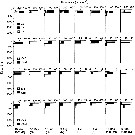 issued from : Y. Nishibe & T. Ikeda in Mar. Biol., 2007, 150. [p.613, Fig.3]; issued from : Y. Nishibe & T. Ikeda in Mar. Biol., 2007, 150. [p.613, Fig.3];
Triconia borealis. Vertical distribution of each developmental stage (C1-C6) at site H (41°30'N, 145°47'E, depth 6,670 m, in the Oyashio region).
Female and male data are shown separately for C4-C6.
Abbreviations are D day, N night. |
 issued from : Y. Nishibe & T. Ikeda in Mar. Biol., 2007, 150. [p.612, Fig.2]; issued from : Y. Nishibe & T. Ikeda in Mar. Biol., 2007, 150. [p.612, Fig.2];
Vertical profiles of temperature (solid line) and salinity (broken line) at site H (41°30'N, 145°47'E, depth 6,670 m, in the Oyashio region). |
| | | | Loc: | | | W Medit. (Gulf of Annaba in Khelifi-Touhami & al., 2007); Liguro-provençal Channel: in Mazza, 1966), N Red Sea (Sharm El-Sheikh, Taba), Woods Hole, off E Nova Scotia, St. Lawrence Estuary, Saguenay fjord, off Newfoundland, Cape Flemish, Greenland (W, Godthaab Fjord, Kejser Franz Joseph and Scoresby Sund Fjord), Baffin (Lancaster Sound, W Baffin Bay); Greenland Sea, Fram Strait, N Spitsbergen, Kongsfjorden ( W Spitsbergen), Iceland, Norwegian Sea, Oslo fjord, Lysefjorden, North Sea, Arct. (White Sea, Barents Sea, Franz Josef Land, Pechora Sea, Laptev Sea, Chupa Inlet, Lomonosov Ridge, Kara Sea, Fram Strait, Ellesmere Is., Canadian abyssal plain, Nansen Basin, Amunsen Basin, Barrow Strait, Makarov Basin, E Siberia, Chukchi Sea, Bering Sea, off NW Alaska, SE Beaufort Sea, Canada Basin, Beaufort Sea), Korea, Japan Sea, Oyashio region, S Kuril Is., Station "P", Strait of Georgia, Washington inland, Oregon (Yaquina, off Newport) | | | | N: | 95 | | | | Lg.: | | | (45) F: 0,7-0,6; M: 0,45-0,35; (133) F: 0,7; M: 0,4; (134) F: 0,75; (141) F: 0,7; M: 0,4; (675) F: 0,76-0,64; M: 0,56-0,44; (796) F: 0,8-0,69; M: 0,54-0,46; (1064) F: 0,564-0,687; M: 0,38-0,398; (1174) F: 0,56-0,69; M: 0,38-0,40; {F: 0,56-0,80; M: 0,35-0,56} | | | | Rem.: | epi-mesopelagic in the polar basin.
Collected by Heron & al. (1984, p.467) in samples mainly from above 500 m.
Heron & Frost (2000, p.1017) do not agree that the generic definition of Triconia by Böttger-Schnack (1999) is sufficient to justify inclusion of all of the divergent species she assigned to the new genus.
The occurrence of this species in western Mediterranean Sea is rare and needs confirmation.
For Wi & al. (2010, p.688) the species from Korean waters shows the typical morphological characteristics of T. borealis (cf. Sars, 1918); Heron & al. (1984) including some important details lacking in Sars' description. | | | Last update : 25/09/2020 | |
|
|
 Any use of this site for a publication will be mentioned with the following reference : Any use of this site for a publication will be mentioned with the following reference :
Razouls C., Desreumaux N., Kouwenberg J. and de Bovée F., 2005-2024. - Biodiversity of Marine Planktonic Copepods (morphology, geographical distribution and biological data). Sorbonne University, CNRS. Available at http://copepodes.obs-banyuls.fr/en [Accessed April 27, 2024] © copyright 2005-2024 Sorbonne University, CNRS
|
|
 |
 |


















